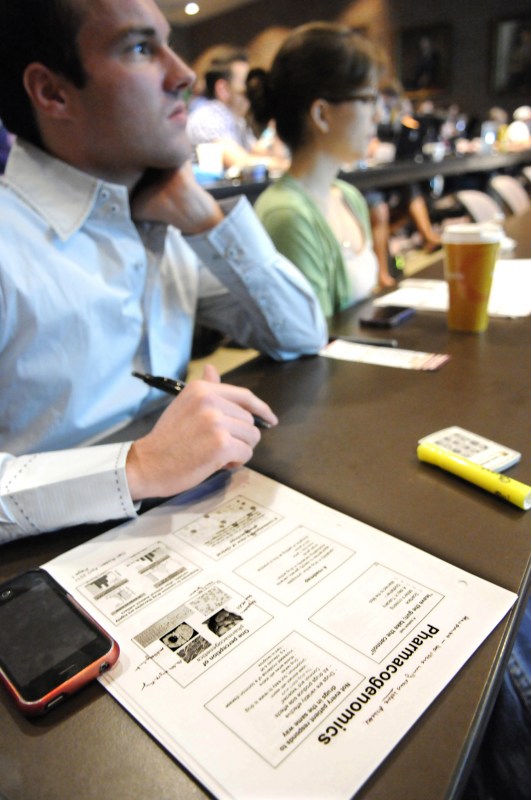
Colby Uptegraft was among the VUSM students who had their DNA tested as part of a special genomics course. (Photo by Mary Donaldson)
School of Medicine course lets students test own DNA
A new offering for second-year Vanderbilt University School of Medicine students as part of a clinical pharmacology course on genomics became a bit of a research project in and of itself when students were given the opportunity to have their own DNA analyzed by the commercial company 23andMe.
During a special class session entitled “Student Genome,” Ellen Wright-Clayton, M.D., J.D., director of the Center for Biomedical Ethics and Society, joined Dan Roden, M.D., assistant vice chancellor for Personalized Medicine and principal investigator for BioVU, to discuss what students had learned.
Clayton and Roden introduced the idea last summer and again in January, and more than half the class elected to have the analysis performed.
Even among these healthy, 20-something students, there were some concerns — about the results, about the test itself, and above all, about the use of this very personal information.
“I chose to use a pseudonym, and a few students opted out of the testing altogether. I was more concerned about security aspects of the information than the results,” said student Jesse Wright.
With clickers in hand, students were asked to respond anonymously with their personal feelings about the service.
About 10 percent said they wouldn’t share the information they learned with family members and almost 40 percent said they didn’t plan to share it with their own physician.
“I was pretty excited to see the results actually. It’s cool that it can predict risks, although not everything 23andMe tells you is a complete surprise. It listed me as high risk for having red hair and developing skin cancers,” said redheaded, fair-skinned Tyler Winders.
Amanda Harris learned something a little more potentially alarming.
According to 23andMe, she might over-respond to a common blood-thinning drug called Warfarin, putting her at increased risk of bleeds should she ever need the medication.
But when Harris investigated further, putting her genotype information into a calculator from a website called warfarindosing.org, she received exactly the opposite dosing advice.
“That was surprising, so what do I do at that point?” Harris asked Roden during lecture.
Roden said that this was part of the lesson to be learned.
He explained that little is known right now about how to apply the information in medical practice, although that is almost certainly the goal in paying for genotyping.
Clayton and Roden said these are the very thoughts and discussions students must have now in medical school.
Today, any patient can have their DNA analyzed for a few hundred dollars.
“I view this experience as an absolutely necessity. You can educate students by showing them slides, but if you have the genetic testing done on yourself, there’s something more personal and educational about looking at your own data,” Roden said.
“There’s a need to know not only about the things that it (genetic testing) can offer, but about the things that it can’t,” Clayton said.
“That’s enormously important. There’s been an awful lot of hype around this and I’m pretty sure that patients will do better if we call the impact correctly and not over-call it.”
Dana Crawford, Ph.D., assistant professor of Molecular Physiology and Biophysics, and Josh Denny, M.D., MPH, assistant professor of Biomedical Informatics and of Medicine, talked about specifics of the testing. Crawford presented on ancestry data and Denny on drug predictions, like those involving Warfarin.













